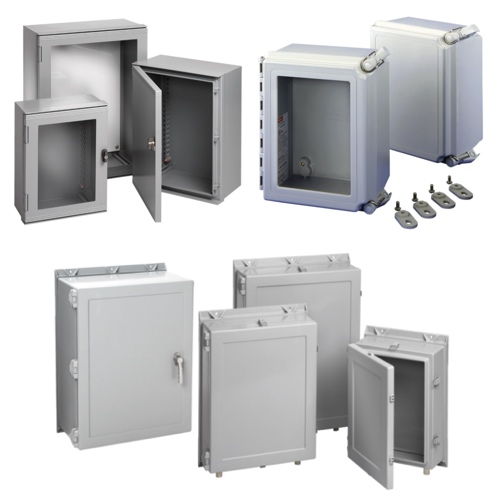nVent Hoffman Fiberglass Enclosures

nVent Hoffman fiberglass enclosures are known for their exceptional strength and long life. This is because of their design using advanced fiberglass-reinforced polyester (FRP) technology that provides a high-strength-to-weight ratio. These enclosures serve as robust, lightweight alternatives to traditional metal enclosures. The non-conductivity of the FRP material enhances the structural performance and ensures the safety and reliability of the housed electrical components.
Whatever the circumstances—whether sweltering hot or freezing cold; exposed to harsh or corrosive elements or noxious gases; or besieged by intense sunshine, salt, or rain, you name it—nVent Hoffman enclosures stay intact and maintain their functionality. That’s because they are built to last. They're robust, and they feature a design that inherently keeps the inner workings not just clean but dust free. Plus, with their gasket systems, rigidity, and reliable locking mechanisms, they securely protect the components inside and help the enclosures live up to their long-term promise.
More Information about nVent Hoffman Fiberglass Enclosures
nVent Hoffman fiberglass enclosures are designed to provide ease of access for maintenance and modifications. You can opt for a hinged cover that is easy to open and close, and it will still secure the enclosure when it is not open. Mounting can be in a variety of ways, including wall or pole mounts, so they are versatile for different installation scenarios. All these features mean you can use these enclosures in a variety of settings, but no matter what, they provide the performance you need in an outdoor environment.
Fiberglass enclosures by nVent Hoffman come in many sizes and can be arranged in different ways. This allows customization to meet the precise needs of an application and is the basis for their use in a diverse range of industries. Some of the main applications for nVent Hoffman's fiberglass enclosures are in industries such as telecommunications, utilities, and industrial automation. In these industries, they are used to protect components that are electric or electronic and have to work reliably—mostly because when such components fail, the big things they are attached to also fail.
nVent Hoffman non-metallic enclosures are available in a wide selection of sizes and configurations. You can find them as junction boxes, wall-mount enclosures, and free-standing enclosures. And you get mounting options and accessories that make these enclosures usable. nVent Hoffman provides an array of ways to mount your equipment inside the enclosure. You can also buy back panels, hinged covers, and padlocking provisions to keep things secure. These conveniently available accessories make configuring and using the box a snap. In this feature-rich environment, you can put just about anything you need to house into a nVent Hoffman non-metallic enclosure.
Non-Metallic Enclosure Types
Characteristics of non-metallic enclosures:
NEMA 4x rating for outdoor use providing chemical resistance and protection from dust, debris, water and rain.
High insulation value, which provides insulation from cold and hot temperatures, but does not dissipate heat from inside the enclosure.
Non-conductive, meaning components cannot be grounded to the enclosure, but it still provides the product the same security and tamper resistance levels as metallic enclosures when properly locked.
Types of non-metallic enclosures:
Fiberglass
A thermoset polyester material reinforced with glass fibers. It is the most widely used non-metallic material in the industry. It has high impact strength and rigidity (dimensional stability), a superior working temperature range (-31˚F to 300˚F), excellent electrical properties, moisture and chemical resistance, as well as being cost effective.
Polycarbonate
High-performance thermoplastic resin processed by injection molding or sheet extrusion. It has superior impact resistance, good rigidity (dimensional stability), an extended temperature range (-31˚F to 180˚F), excellent electrical properties, fire retention, UV stability and corrosion resistance in some acidic surroundings. It is not suitable for environments with strong alkalis and organic solvents.
ABS or ABS blends
Acrylonitrile Butadiene Styrene is a common thermoplastic polymer processed by injection molding. It has high impact resistance, but less impact resistance in cold weather compared to polycarbonate, excellent electrical properties, superior chemical and moisture resistance, but a narrower temperature range than fiberglass (-40˚F to 248˚F).
Polyester
High-performance unfilled thermal plastic processed by injection molding. It has high impact resistance, but less impact resistance in cold weather than polycarbonate, excellent electrical properties, superior chemical and moisture resistance, but a narrower temperature range than fiberglass (-40˚F to 248˚F).

